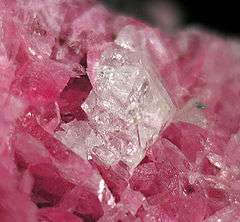Cahnite
| Cahnite | |
|---|---|
|
Cahnite on rhodonite | |
| General | |
| Category | Borate minerals |
| Formula (repeating unit) | Ca2B[AsO4](OH)4 |
| Strunz classification | 06.AC.70 |
| Identification | |
| Color | Colorless to white |
| Cleavage |
Perfect On {110} |
| Tenacity | Brittle |
| Mohs scale hardness | 3 |
| Luster | Vitreous |
| Diaphaneity | Transparent |
| Density | 3.156 g/cm3 |
Cahnite (Cahnit in German, Cahnita in Spanish, Канит in Russian[1]) is a brittle white or colorless mineral that has perfect cleavage and is usually transparent. It usually forms tetragonal-shaped crystals and it has a hardness of 3 mohs.[2][3] Cahnite was discovered in the year 1921.[1] It was named Cahnite to honor Lazard Cahn (1865–1940), who was a mineral collector and dealer.[2] It is usually found in the Franklin Mine, in Franklin, New Jersey.[3][2] Until the year 2002, when a sample of cahnite was found in Japan, that was the only known place that cahnite was located.[4] The geological environment that it occurs in is in pegmatites cutting a changed zinc orebody.[1][2][3] The chemical formula for cahnite is Ca2B[AsO4](OH)4.[3][5][6] It is made up of 26.91% calcium, 3.63% boron, 25.15% arsenic, 1.35% hydrogen, and 42.96% oxygen. It has a molecular weight of 297.91 grams.[3] Cahnite is not radioactive.[2] Cahnite is associated with these other minerals: willemite, rhodonite, pyrochroite, hedyphane, datolite, and baryte.[1]
